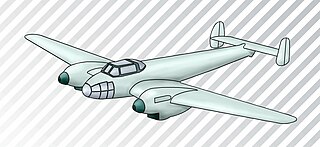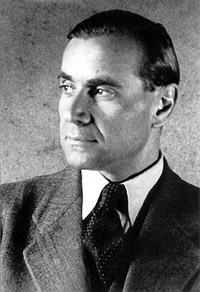
The Henschel Hs 129 was a World War II ground-attack aircraft fielded by the German Luftwaffe. The aircraft saw combat in Tunisia and on the Eastern Front.

Henschel & Son was a German company, located in Kassel, best known during the 20th century as a maker of transportation equipment, including locomotives, trucks, buses and trolleybuses, and armoured fighting vehicles and weapons.

The Henschel Hs 293 was a World War II German radio-guided glide bomb. It is the first operational anti-shipping missile, first used unsuccessfully on 25 August 1943 and then with increasing success over the next year, ultimately damaging or sinking at least 25 ships. Allied efforts to jam the radio control link were increasingly successful despite German efforts to counter them. The weapon remained in use through 1944 when it was also used as an air-to-ground weapon to attack bridges to prevent the Allied breakout after D-Day, but proved almost useless in this role.

The Wasserfall Ferngelenkte FlaRakete was a German guided supersonic surface-to-air missile project of World War II. Development was not completed before the end of the war and it was not used operationally.

The Henschel Hs 123 was a single-seat biplane dive bomber and close-support aircraft flown by the German Luftwaffe during the Spanish Civil War and the early to middle of World War II. It proved to be robust, durable and effective especially in severe conditions. It continued to see front-line service until 1944, only to be withdrawn due to a lack of serviceable airframes and spare parts.

The Junkers Ju 390 was a German long-range derivative of the Junkers Ju 290 aircraft, intended to be used as a heavy transport aircraft, maritime patrol aircraft and long-range bomber. It was one of the aircraft designs submitted for the abortive Amerikabomber project, along with the Messerschmitt Me 264, the Focke-Wulf Ta 400 and the Heinkel He 277.

The Henschel Hs 127 was a German bomber that was built as two prototypes, but cancelled without entering mass production.

The Messerschmitt Bf 162 was a light bomber aircraft designed in Germany prior to World War II, which flew only in prototype form.

Wunderwaffe is a German word meaning "wonder-weapon" and was a term assigned during World War II by Nazi Germany's propaganda ministry to some revolutionary "superweapons". Most of these weapons however remained prototypes, which either never reached the combat theater, or if they did, were too late or in too insignificant numbers to have a military effect. The V-weapons, which were developed earlier and saw considerable deployment, especially against London and Antwerp, trace back to the same pool of highly inventive armament concepts. In the German language, the term Wunderwaffe generally refers to a universal solution which solves all problems related to a particular issue, mostly used ironically for its illusionary nature.

The Henschel Hs 294 was a guided air-to-sea missile developed by Henschel Flugzeug-Werke in Germany during World War II.

Wilhelm Schmidding from Bodenbach, Germany, was a World War II constructor of rocket engines used for RATO. Factories were in Schmiedeberg, and from summer 1943, in Buschvorwerk.

Herbert Alois Wagner was an Austrian scientist who developed numerous innovations in the fields of aerodynamics, aircraft structures and guided weapons. He is most famous for Wagner's function describing unsteady lift on wings and developing the Henschel Hs 293 glide bomb.

The Blohm & Voss BV 143 was an early prototype rocket-assisted glide bomb developed by the German Luftwaffe during World War II.

The Henschel Hs 298 was a 1940s German rocket-powered air-to-air missile designed by Professor Herbert Wagner of Henschel.

Feuerlilie was the code name of a German anti-aircraft missile, which was developed in 1940 and was shelved because of problems with the controller and the drive section at the end of January 1945 in favour of other projects. The Feuerlilie was built and tested at Rheinmetall-Borsig in two versions: the F-25 with a diameter of 25 cm, and the larger F-55 55 cm in diameter. The engines were Rheinmetall 109-505/515 solid rockets.
The BMW 109-558 is a liquid fuelled sustainer rocket motor developed by BMW at their Bruckmühl facility, in Germany during the Second World War.















